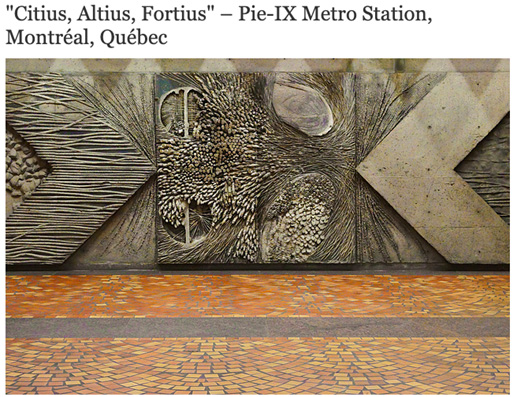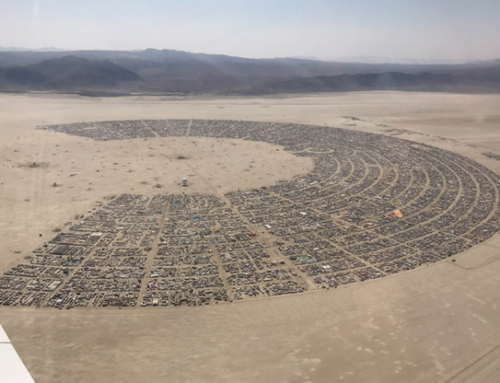Having lived in Montreal for over 4 years, I am able to observe the special ways that architecture, art, and urban planning play a unique role as they interact with people’s everyday routines. A closer look at my environment is enough to affirm the importance of art in securing a city’s identity and subsequently, its residents’. A large component of this is Montreal’s intricate public transportation- the STM metro system — and specifically, some of the installed artwork exhibited or built into the metro stations.
Pie-IX, located in Hochelaga-Maisonneuve in Montreal, is a Metro station on the Green Line of the Montreal Metro. As a result of development plans for the 1976 Summer Olympics, Pie-IX station opened on June 6, 1976. Inside the station is a long concrete and aluminum mural designed by architectural artist Jordi Benet. The piece (pictured below) is titled after the Olympic Motto, “Citius, Altius, Fortius” or “faster, higher, stronger.” Bonet, regarded as one of Canada’s most highly renowned architectural artists, explored and worked heavily with ceramics, as exhibited in “Citius, Altius, Fortius.”

Fig 1. Picture of Jordi Benet’s mural at Pie-IX Metro Station, “Citius, Altius, Fortius.” (Photograph by Jonathan Cohen. http://www.ipernity.com/doc/jonathan.cohen/28650719. August 18, 2012).
Sandra Alfody’s book, The Allied Arts: Architecture and Craft in Postwar Canada, details the close relationship between architecture and craft. Alfody points readers to public sculptures and their significance with respect to the growing shifts in Canadian architectural history following a modernist trend to the growing incorporation of crafts such as use of ‘tapestries and ceramics’ of large buildings.
Applicable to Bonet’s mural stationed at Pie-IX, Bonet melds concrete material and art in “Citius, Altius, Fortius,” as a testament to his craft as well as the Montreal 1976 Summer Olympics. A testament to the ongoing growth of Montreal’s public art landscape, “Citius, Altius, Fortius,” is a perfect demonstration of how architectural craft and art is embedded in everyday interactions between people and our built environment. Indeed, the physical is built around the heart, mind and virility of the city and its people.
Benet uses ceramics and concrete — two seemingly very static objects. Ceramics, a craft traditionally associated with smaller items; and concrete, most commonly known for its structural use rather than artistic. It is interesting then, how Benet uses these two materials to evoke so much movement and energy. As this article on his mural details, the curves and arrows are put in stark contrast with the rigidity of the station’s concrete. 2
Central to Pie-IX station, Benet’s mural is a centerpiece in this corner of Montreal’s landscape. Though Benet has completed many works around Montreal, “Citius, Altius, Fortius,” is one that shares a connection with a more daily routine– establishing a significant albeit small interaction between the city and its residents.
———————————-
[1] Sandra Aflody, The Allied Arts: Architecture and Craft in Postwar Canada (McGill-Queen’s Press- MQUP, 2012), 33.
[2] Heritage Montreal. “Quartier- Art public et commemoration.” Fonds de Commission de transport de Montréal, Archives of the STM (S10 / 10.1.22 ), http://www.memorablemontreal.com/print/arts_menu.php?quartier=7&batiment=282§ion=Array&menu=projet.
Works Cited:
Alfoldy, Sandra. The Allied Arts: Architecture and Craft in Postwar Canada. Vol. 9. McGill-Queen’s Press-MQUP, 2012.
Cohen, Jonathan. “Citius, Altius, Fortius,– Pie- IX Metro Station, Montreal, Quebec,” last modified December 5, 2013.
http://www.ipernity.com/doc/jonathan.cohen/28650719
Heritage Montreal. “Quartier- Art public et commemoration.” Fonds de Commission de transport de Montréal, Archives of the STM (S10 / 10.1.22 ), http://www.memorablemontreal.com/print/arts_menu.php?quartier=7&batiment=282§ion=Array&menu=projet.



